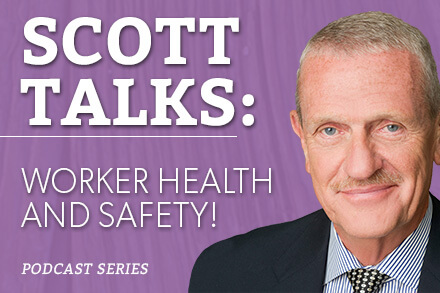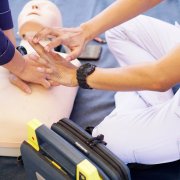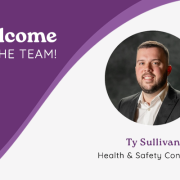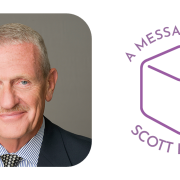 Check out our latest podcast to learn how to create an effective workplace safety program that addresses more than just OSHA compliance.
Check out our latest podcast to learn how to create an effective workplace safety program that addresses more than just OSHA compliance.
Hi everybody, this is Scott Lawson. Remarkably enough OSHA has been around since 1969. However, OSHA does not have a standard that requires companies to have a safety program. They have lots of individual regulations or statutes that you have to have a respirator program and you have to have a confined space program and you have to have a hazard communication program. But nowhere does OSHA say you must have a safety program. And I think we’ve been it been in thousands of companies over the last 40 years and we’ve found this to be one of the biggest problems is that without the need or requirement for having a safety program to just have a bunch of disparate requirements that OSHA has you comply with – it just doesn’t seem to work. In 1989 OSHA published a document that was called Safety and Health Program Management Guidelines issuance of voluntary guidelines and it’s something I’ve given out thousands of times when I do my seminars and lectures and what it is basically a long-winded document. The focus is on four specific or key aspects of the components of a safety program that give you the best chance of having a successful health and safety program. And they’re pretty simple components; in the first one is management commitment and employee involvement. And what that means is simply enough management has to be committed to having an effective safety and health program and has to involve employees in the process. We don’t find this is the case in probably 95 percent of the companies that we go into. There is a safety committee it’s kind of ragtag it’s not organized.
It meets irregularly and generally, it turns out to be a gripe session about production or quality or other issues and it has little or nothing to do with safety. So that’s the first step. The second step is that you have to do what they call a hazard assessment or a job hazard assessment. And most companies are not very good at this because typically what they do is they’ll walk through a plant or look at a piece of machinery and decide what’s unsafe about the machine or the surroundings for that machine and make recommendations for either guarding or bigger exits or bigger aisle-ways or something but they never seem to take into account the human factor and what we find more than anything else is that 95 percent or more of the accidents that happen on the job are the result of people and unsafe acts, and unsafe work practices as opposed to unsafe conditions or for example an unguarded piece of machinery. So, when doing these job hazard analysis, you have to take into account not only the actual hazards of the equipment in the facility, but how can people avoid using the safe equipment and what can they do to create the unsafe acts that they’re going to implement where they’re going to actually get hurt. The third component that she talks about in this is pretty simple. And it says you need to perform or do employee education and training. The majority of the training that I’ve seen happen over the last 40 years used to be videotapes and now in some cases it’s PowerPoint presentations.
Now it’s online training and it is a how fast can you push people through and let them hit the button to make sure that they’ve been through a training exercise. But what ends up happening is after they sit through the training exercise about all they get is a checked box at the end of it and nothing meaningful happens. And 100 years ago, I worked on a project with General Motors where the instructional designers for the course said the goal of an educational process is to have the people who attend or go through that educational process to be able to demonstrate competency in the information that they are presented with. In other words, they’ve got to get something out of the training that will educate them and allow them to see the need to change their behaviors to address the unsafe parts of that process equipment machinery chemical or whatever it is. And we see this happen time and time and time again. What we produce is a sign-up sheet and people who have attended a training session. Their behavior does not change at all and they go right back and keep doing everything the same way they did so that the training and education is a process that is doesn’t really accomplish anything. And one of the things I’ve said forever is you train monkeys and dogs you educate people. And the goal of these things should be to educate your employees so they can do a better job for you. And then the last step in this process is routine evaluation and you sit down every quarter every six months every year and you go through this process and say – is it working? Are people safe or are they wearing their personal protective equipment.
Are there fewer injuries on the job. And if things are working well then keep doing what you’re doing, and if it’s not working well you try to evaluate where the holes are in that process and go back and plug them. And we find the biggest one is that when managements committed to it, they are but they’re not. When we find employees are involved in it, they are but they’re not. The Hazard assessments are poor or nonexistent, and what a lot of people do is what I call find and fix safety. They go through and they look for unguarded machines or blocked exits or blocked aisles. They write up a list of things that need to be fixed. The Maintenance department creates work orders they go and fix it and then the safety committee goes around next month or next quarter and finds exactly the same things all over again create more work orders and somebody goes and fixes those things that people took out of out of service. That doesn’t work at all. What OSHA has done in 2015 is come up with a whole new take on these four steps and they’ve included it into what they call OCA Safety and Health Program Management Guidelines: November 2015 draft for public comment. This is available on the Internet. You can Google it. In fact, you find it easier if you’re not at the OSHA website oddly enough.
And as much of the stuff that OCA does that, I have problems with I think this is actually pretty good, and it’s pretty good because for companies that don’t have a professional staff or people who are trained safety and health personnel it actually can walk you through the steps in the process. And there I believe it’s eight steps altogether and it’s changed a little bit from the four steps before. But its management leadership is the first step, worker participation, hazard identification, and assessment, hazard prevention and control, education and training, program evaluation and improvement which is the let’s go back and see what’s working part. And then the last one is coordination and communication on multi-employer work sites. That’s an important part but its kind of gets in the way of some of the first steps. But the good part about this document is it walks you through all of these steps in terms of explaining more what’s required but then it actually gives you action items that you can implement on your own. What we’ve found from doing this for me in my case 45 years – every company has a company culture associated with it. And every company is different. They all have their own personality. And so, what you really need to do is to take a look at these eight steps and see how it fits your culture, your management team, your ownership team, the employees, businesses or industries rather that are either dirty industries, don’t fare as well with these as high-tech industries with clean rooms. And it’s the nature of the work that gets done. It’s harder to get employee behaviors to change in some of the dirty industries. It’s less hard. I won’t say it’s easier it’s less hard in some of the cleaner industries because you tend to have people who are highly governed by the need to do things correct in those higher-end industries. But it’s certainly worth taking a look at. And if you’re thinking about developing a safety program and or safety committee both of these documents are inordinately helpful, and you can get both of them by looking online or if you want to call our office, we can certainly help you with it.





 Check out our latest podcast to learn how to create an effective workplace safety program that addresses more than just OSHA compliance.
Check out our latest podcast to learn how to create an effective workplace safety program that addresses more than just OSHA compliance.